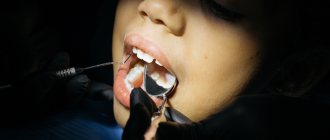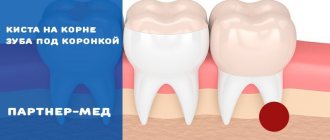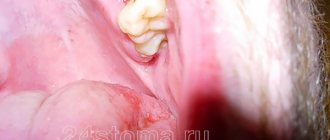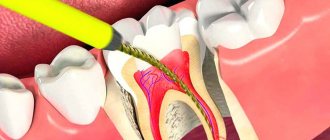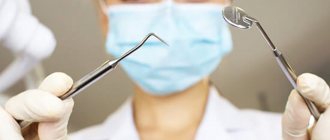From this article you will learn:
- whether wisdom teeth are treated or removed,
- indications and contraindications for treatment,
- Is it possible to remove a wisdom tooth - while it has not yet erupted.
Wisdom teeth are called eighth teeth - according to the serial number in the dental formula (counting is from the central incisors, respectively, for each half of the dentition of the upper and lower jaw). There are four wisdom teeth in total, and they always begin to erupt in the jaw later than all other teeth in the permanent dentition - usually between 18 and 21 years, although in some cases this can happen at 14 years, and even after 40 years. Is it necessary to remove wisdom teeth since they cause so many problems for most of their owners?
To remove or treat a wisdom tooth is determined in dentistry according to a number of criteria. For example, the most important of them is whether there is enough space in the dentition for their normal eruption. After all, for example, if the length of the lower jaw is insufficient, then the lack of space in the dentition will certainly cause their difficult eruption, accompanied by inflammation of the gums and pain. But that's not all, because... the constant pressure of a wisdom tooth trying to erupt on the 7th tooth in front is highly likely to lead to displacement of the teeth and the occurrence of crowding in the anterior sections of the dentition.
Eruption of wisdom teeth –
But very often the question: is it worth removing wisdom teeth - is asked in relation to already erupted, for example, partially destroyed eighth teeth. Whether such wisdom teeth are treated depends, for example, on the correct position of the tooth in the dentition, or on the presence of an antagonist tooth (with which the closure occurs), etc. Moreover, the opinion of dentists of different specializations may differ radically. For example, when you visit a dental surgeon, the doctor may immediately recommend that you remove it, just so as not to sit idle. The same applies to dental therapists.
It is best for the decision on the need to remove or treat a wisdom tooth to be made by an orthopedic dentist (prosthetist), because the most important thing is to make this decision precisely from the point of view of the need for this tooth for prosthetics in the future. As for the issue of removing figure eights if their eruption is difficult, it is advisable that such a decision be made by an orthodontist. Because, again, when you have an appointment with a dental surgeon, often such doctors do not even look at the length of the jaws, but immediately recommend removing the eights, although they could have erupted quite normally.
Content
- Reasons for the development of pathology
- Which doctor should I contact if my tooth has chipped?
- Activities before visiting the dentist
- Microprosthetics
- Place a crown on a chipped tooth
- When is implantation necessary?
Tooth decay is an unpleasant event that requires immediate response. This can happen due to injury, untreated caries, brittle teeth and other reasons. Any chips, even small ones, mean a violation of the integrity of the enamel. That is, the tooth becomes vulnerable, infection can enter and the destruction of the crown part can continue. The patient begins to feel discomfort and pain when exposed to hot and cold temperatures, sweet and sour. The sharp edge of the chip injures the soft tissue of the gums during chewing, and bacteria penetrating into the wound cause inflammation. To restore your tooth and avoid negative consequences, you should immediately make an appointment with a specialist.
Reasons why a tooth may chip
- When teeth are injured, they often chip.
- The immune system affects the strength of tooth enamel.
- There is an imbalance in the hormonal system in the body.
- Eating hard and unhealthy foods can lead to chipped teeth.
- An incorrect bite can cause damage to the integrity of the teeth.
- Tooth enamel is in the stage of demineralization.
- Presence of a crack in the tooth.
Poor bite is one of the most common causes of chipped teeth. When chewing food, the teeth of the lower and upper jaw injure each other and cause chipping. Nighttime teeth grinding can also cause chipped teeth.
Bad habits (smoking, alcohol) thin the enamel of teeth, on which cracks may appear that turn into chips. An imbalance in the acid-base balance in the mouth also thins the enamel, which becomes fragile and breaks easily.
Chronic diabetes mellitus causes hormonal imbalance, which affects dental health.
Reasons for the development of pathology
Damage can be caused by several direct or indirect factors. Determining the cause is an important aspect for proper treatment. Among these factors:
- Mechanical damage due to trauma.
- Chipping due to bad habits (biting nails, pens, and other objects not intended for this purpose).
- Reduced acidity of the oral cavity, which negatively affects the strength of enamel.
- Bite defects.
- Dental pathologies that have not received treatment.
- Remineralized enamel.
- Hormonal imbalances, changes during pregnancy.
- Frequent consumption of excessively hot or cold foods.
- Night grinding of teeth.
How is a decayed tooth removed?
The process of tooth extraction is a simple dental operation. The difficulty increases when you need to remove the root of a tooth that is completely destroyed. Factors requiring the intervention of an experienced specialist:
- small size of the remaining crown;
- condition of surrounding tissues;
- the location of the remaining hard tooth tissues under the upper edge of the gums;
- defects of gums, roots.
Affects the complexity of the operation and whether the position of the upper or lower jaw belongs. In the upper jaw, the walls of the sockets are longer and thicker; accordingly, teeth are removed from them with great difficulty - a highly qualified dentist is required to perform the manipulation.
Wisdom teeth, from which only the root remains, are removed in the same way as ordinary molars, but in some patients, healing after such an intervention is very painful.
Examination and preparation
The procedure begins with a thorough examination and preparation of the patient. When you first visit the clinic, the doctor will take an x-ray and examine the oral cavity.
Doctor's tasks:
- determine the condition of the tooth, assess the extent of destruction;
- clarify the presence of allergies, contraindications, inflammation;
- choose a method of pain relief;
- draw up an operation plan;
- prepare tools.
The tools used to remove a rotten tooth root are a drill, forceps, and a set of elevators (photo).
A prerequisite is hygienic treatment of adjacent tissues. Extraction is possible only after removing stones and plaque from the molars, incisors or canines surrounding the surgical field. Immediately before extraction, the oral cavity is treated with a Chlorhexidine solution.
Anesthesia
There are cases when dentin is destroyed gradually, without inflammation, without the appearance of rot. In such situations, painless root removal is possible without the use of painkillers, however, anesthesia is more often necessary.
The choice of drug is carried out taking into account:
- age;
- allergic status;
- presence of somatic diseases;
- individual intolerance to drugs;
- presence of chronic diseases: epilepsy, diabetes;
- complexity of the upcoming operation.
The patient must notify the dentist about any deviations before the procedure begins. In most cases, the tooth root is removed under local anesthesia - one or two injections for incisors, 2 to 4 injections into the gums for molars. But if two teeth are destroyed, or the jaw is to be opened, the patient receives general anesthesia - he will sleep until the doctor finishes pulling out the tooth.
Features of pain relief for a tooth with a rotten root
An anesthetic injection is given at the site of the projection of the tooth roots. But if the medicine is injected into the rotten area, it may not work and the person will be hurt during the extraction process.
Treatment of patients with rotten roots is carried out in two stages. On the first visit, the dentist numbs the gum, prepares it and cleans it of pus. During the second visit, anesthesia is repeated, and the doctor removes the root that has rotted inside the gum.
Removal
The doctor decides how to remove a tooth if only the root remains. Usually they start with the use of forceps. Even if the destroyed roots remain under the gum, the holes do not completely heal - the dentist can carefully pick up the remnants of hard tissue and easily pull them out.
If the tooth has crumbled to the very base, it is pulled out with an elevator. Having inserted the instrument between the gum and dentin, the doctor presses on the handle and makes rotational movements of small amplitude. As a result, the periodontal fibers shift and the root is squeezed out of the socket.
A drill is used when it is necessary to crush the hard tissues of a molar before removal. With proper anesthesia, this procedure is painless; discomfort is possible only when the gums are already healing.
Relieving inflammation
When removing a rotten root, an inflammatory process is often detected. To ensure that the wound heals safely and does not fester, it is customary to treat it with an antiseptic. But one treatment will not provide adequate prevention, so an anti-inflammatory drug is placed in a fresh hole. With it, the hole will heal faster, and the patient will have less chance of developing alveolitis.
Stitching
To extract the root system, the doctor separates and lifts flaps of soft tissue; they can only be attached back by suturing. It is customary to tighten the edges of the holes with threads during double or triple removal, when a significant part of the gum has been subjected to preparation. This is done so that the affected area heals faster and does not cause discomfort to the patient.
Activities before visiting the dentist
Depending on the extent of the damage, the patient may feel discomfort from increased sensitivity and pain. If a sharp edge is formed after the chipping, it will scratch the gum, tongue, and cheek. Such damage is a favorable environment for infection. The sharp edge must be isolated as soon as possible. A tooth that has lost full enamel protection is also vulnerable to infection.
While waiting for a visit to the dentist, the patient can take a number of actions to minimize negative consequences:
- Do not put any pressure on the affected tooth or chew hard food on its side.
- Thoroughly clean the chipped area, avoiding the accumulation of food debris and plaque.
- Rinse with a soda solution (you can add iodine and salt).
- If your chipped tooth hurts, you can take a pain reliever.
PROMOTION
Hygienic teeth cleaning
2000 rub.
Indications for removal
In some circumstances, removing the “eight” becomes the only way out. In particular, the doctor will decide to get rid of the eighth tooth if:
- It is located at an angle and when cutting through it puts pressure on the roots of its neighbors;
- A partially erupted tooth injures the gums;
- When affected by caries, the treatment area is difficult to reach;
- The roots of the "eight" grow in the maxillary sinus;
- The patient suffers from facial neuralgia;
- Complications developed;
- There is a gum cyst in the eruption area.
Microprosthetics for tooth restoration
To restore the aesthetics and full function of a damaged tooth, restoration is used. If the chip is small, the problem can be solved using composite materials. For more significant damage, microprosthetics would be an excellent option. Inlays, which serve as microprostheses for restoring teeth, are made from composite materials based on an impression. They are durable and aesthetic, and are widely used in modern dentistry.
Micro-prostheses also include veneers. These are thin plates that are attached from the outside to the prepared teeth (in the frontal zone of the dentition, covering the front part and lower edge of the tooth). Veneers are also made from impressions and are effective in correcting most aesthetic problems. The plates are mainly made of ceramics and zirconium dioxide.
If the injury affects the pulp, the specialist treats the canals, and then fills or installs a microprosthesis.
Features of wisdom teeth treatment
Wisdom tooth decay is treated using the same algorithm as regular teeth. The procedure is performed under local anesthesia, but therapeutic manipulations can also be performed under sedation. This method of anesthesia is recommended for a planned long-term procedure, treatment of the figure eight of the upper jaw, an increased gag reflex and limited mouth opening.
The features of the manipulations depend on the indications. The initial and middle stages of the disease will only require the removal of tissue affected by caries and the installation of a filling.
Deep caries is an indication for a more complex procedure:
- tissues affected by caries are removed using a drill;
- tooth canals are cleaned;
- antiseptic treatment is performed;
- a medicine is placed into the tooth cavity;
- a temporary filling is installed;
- after 3–10 days the temporary filling is removed;
- antiseptic treatment is repeated;
- A permanent filling, inlay or crown is installed.
Treatment of wisdom teeth caries should only be performed by an experienced dentist. If mistakes are made during the procedure, the likelihood of complications or relapse is very high. When re-applying, the eights are usually deleted.
Installing a crown on a chipped tooth
In case of significant injuries, if it is impossible to restore the crown part of the tooth, a new tooth can be obtained using prosthetics. The prosthesis - crown - is fixed on the root of the tooth if this part remains healthy and strong. Different types of crowns are used depending on the material of manufacture:
- Metal ceramics are the most inexpensive option. The design is durable due to the metal base, and aesthetic due to the ceramic layer. Such dentures become an ideal option for budget restoration of teeth in the chewing area. Installation of metal ceramics in the frontal area is possible, but the tooth will not look natural due to the lack of transparency.
- Zirconium dioxide is a modern high-tech material that has both the strength and aesthetics of natural teeth. Such crowns are made using computerized technology and are practically indistinguishable from natural teeth in appearance. They refract light correctly and have a certain degree of transparency, similar to tooth enamel.
- Ceramic crown. This option is only suitable for the front teeth, since the structure is not strong enough to withstand the full chewing load. Ceramics look very aesthetically pleasing.
Restoration method – bridge prosthesis
Dental bridges got their name for their visual resemblance to a bridge - they are a structure of two crowns, between which artificial teeth are located.
Crowns are placed on your own ground teeth. The advantages of bridges are good aesthetics and reliable fixation. Dental bridges are permanent, making them very comfortable. This type of dental prosthetics requires several visits to the doctor. First, impressions are made, from which a temporary prosthesis is made in a denture laboratory or clinic - the patient will not experience discomfort when communicating due to the absence of a front tooth. At the same time, the dental clinic prepares the supporting teeth. They are ground to install a crown to a shape that is optimally suitable for this, and most often (but not always) they are depulped. After the grinding is completed, impressions are taken again, from which dentists make a permanent prosthesis, and after that it is installed on the supporting teeth and fixed with cement.
The main disadvantage of a bridge is the need for depulpation and grinding of healthy supporting teeth. In addition, its installation, which leads to an uneven load on the alveolar bone and its thinning in the area of the missing tooth..
When is implantation needed?
Implantation is required if the root part of the tooth is damaged and cannot be used as a support for a prosthesis. This can happen when the side wall of the tooth is broken (below the gum level), deeply damaged by caries, root fracture, etc. In these cases, the tooth is completely removed and replaced with a titanium rod - an implant. Crowns are also placed on implants. These are metal ceramics and zirconium dioxide; ceramic prostheses are not used due to their high fragility.
Generalized scheme for tooth extraction
The process of removing any tooth includes the following steps:
- Examination and collection of anamnesis (allergic status, information about the state of health and the dental apparatus).
- Preparation of the surgical field: treatment of the injection site, rinsing the mouth with an antiseptic.
- Anesthesia.
- Detachment of gum from tooth using a trowel.
- Loosening a tooth with forceps.
- Extracting a tooth from its socket.
- Treating the hole with an antiseptic.
- Stop bleeding with tamponade.
According to this scheme, simple removal is carried out. In some situations, for example, when a wisdom tooth or a badly damaged molar is pulled out, a complex extraction is required. Its main difference is that in addition to forceps, the dentist uses a drill to cut out bone tissue or saw the root into pieces, a chisel, a hammer and other dental instruments.
Wisdom tooth removal diagram
Getting rid of a wisdom tooth can be especially difficult. Due to its location in the posterior quadrant of the jaw, access to it is difficult. With anatomically incorrect or curved roots, which are often found in third molars, the dentist may be forced to make incisions in the gums, pull out the root piece by piece, and then apply sutures.
Prevention of dental diseases
A number of simple steps will help the patient keep his teeth healthy for as long as possible and reduce the likelihood of diseases:
- Careful hygiene, brushing teeth at least twice a day.
- Using dental floss and rinsing with special solutions.
- Attention to the condition of soft tissues and gums.
- Timely visit to the dentist if alarming symptoms appear, preventive examinations twice a year.
How to pull a tooth at home without pain
How to relieve toothache at home
What complications can there be?
The gradual destruction of the figure eight inevitably leads to the development of inflammatory processes, because a crown with large chips quickly becomes a breeding ground for harmful bacteria. In this case, the damage rapidly spreads deep into the hard tissues, moving to dentin and pulp. This situation is fraught with the appearance of acute symptoms: severe pain and the onset of suppuration processes. Urgent removal of the causative element is required, but such conditions significantly complicate the doctor’s task. If the cause is caries, the pathology can easily spread to the adjacent molar and lead to its destruction.
Myth six: after filling, do not eat for 2 hours
The recommendation to limit food intake after a filling procedure is still stable. Moreover, people often give it to themselves. “Before, the doctor put a filling and said that you need to not eat for 2 hours. Now this limitation is only due to the fact that we use anesthesia during treatment. After this, the patient does not feel part of his cheek and lip. By starting to chew in this state, the patient runs the risk of biting himself. That’s why I always say that you can eat as soon as the anesthesia wears off,” says Ilya Antonov.



